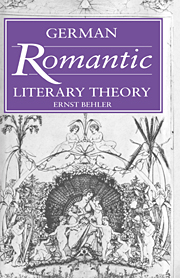Book contents
- Frontmatter
- Contents
- Preface
- List of abbreviations
- Chronology of early Romanticism
- Introduction
- 1 Formation and main representatives of early Romanticism in Germany
- 2 Poetry in the early Romantic theory of the Schlegel brothers
- 3 The theory of Romantic poetry
- 4 Novalis and the mystical dimension of early Romantic theory
- 5 Wackenroder's and Tieck's conceptions of painting and music
- 6 Theory of language, hermeneutics, and encyclopaedistics
- Conclusion: early German Romanticism and literary modernity
- Notes
- Select bibliography
- Index of works cited and primary sources
- Index of subjects and names
Preface
Published online by Cambridge University Press: 17 August 2009
- Frontmatter
- Contents
- Preface
- List of abbreviations
- Chronology of early Romanticism
- Introduction
- 1 Formation and main representatives of early Romanticism in Germany
- 2 Poetry in the early Romantic theory of the Schlegel brothers
- 3 The theory of Romantic poetry
- 4 Novalis and the mystical dimension of early Romantic theory
- 5 Wackenroder's and Tieck's conceptions of painting and music
- 6 Theory of language, hermeneutics, and encyclopaedistics
- Conclusion: early German Romanticism and literary modernity
- Notes
- Select bibliography
- Index of works cited and primary sources
- Index of subjects and names
Summary
Since its appearance in critical writings of the late eighteenth century, especially through the periodical Athenaeum (1798–1800), the early Romantic literary theory of Germany has enjoyed the reputation of having introduced a new manner of thinking about poetry and our approach to literary works in the West. This reputation has manifested itself not only in the appreciation and adoption of a new critical attitude, but also in sharp polemics against its alleged aesthetic absolutism. Such intense scrutiny has resulted in a widespread influence of early German Romantic thought on the critical scene during the nineteenth and twentieth centuries, as evidenced by its reception by Coleridge, Poe, and Baudelaire, by Scandinavian and Slavic critics, and in the literary thinking of the main Mediterranean countries of Europe. This reception has generally understood the early Romantic literary theory of Germany as a rupture with the system of mimesis and representation that had dominated European aesthetic thought during the previous centuries.
A certain disproportion can be detected between the casual origin of the theory and its actual importance and influence on successive centuries of critical thought. The formation of what we call early Romantic theory actually lasted scarcely more than six years, from about 1795 to 1801, and was the communal product of a group of about six young authors of different backgrounds and orientations who, out of mutual interests and communal literary pursuits, assembled for a few years and were ironically labelled the ‘new school’ or the ‘Romantic school’ by their contemporaries. After the turn of the century the members of the group dispersed, each taking his own path.
- Type
- Chapter
- Information
- German Romantic Literary Theory , pp. ix - xPublisher: Cambridge University PressPrint publication year: 1993

